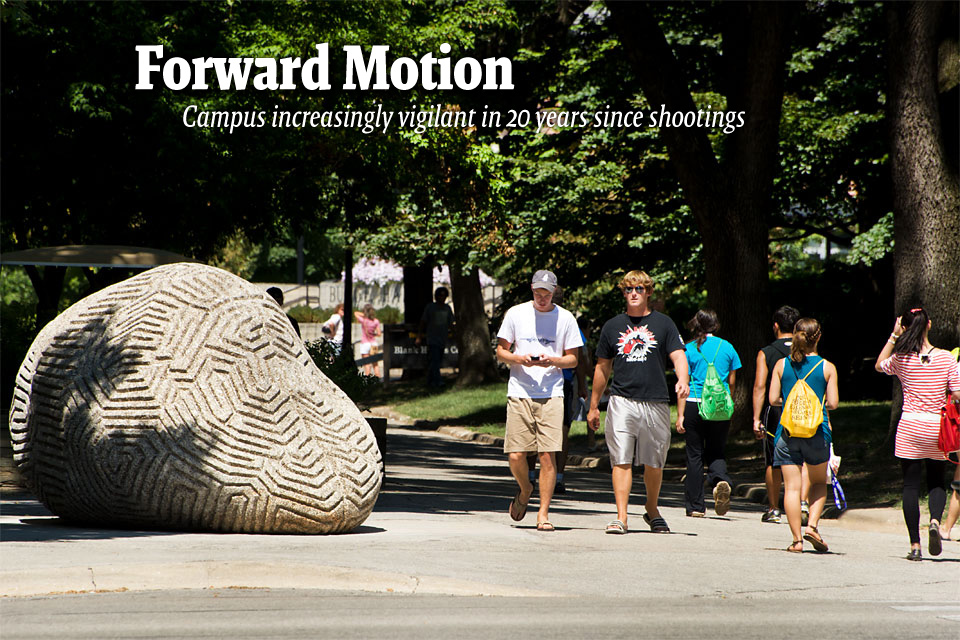-
Page Navigation Links:
- Skip to Site Navigation Links
- Skip to Features

- The University of Iowa
- Spectator
- Monthly News for UI Alumni and Friends
![]()
On Nov. 1, 1991, a former graduate student shot and killed five people on campus and permanently paralyzed another before taking his own life.
The shooter, Gang Lu, had recently received a Ph.D. in physics, and was disillusioned when another graduate student won a prestigious dissertation prize he felt he should have received. He began the rampage during an afternoon physics department meeting in Van Allen Hall, targeting two of his professors as well as the prizewinner, and then sought out and killed the department chair in his office. He then headed a few blocks west to Jessup Hall, where he fatally wounded the associate vice president for academic affairs, injured a student employee, and committed suicide.
The victims were:
• T. Anne Cleary, associate vice president for academic affairs and professor of education

• Christoph Goertz, professor of physics and astronomy

• Dwight Nicholson, professor and chair of physics and astronomy

• Linhua Shan, recent recipient of a doctorate in physics

• Robert A. Smith, associate professor of physics and astronomy

• Miya Rodolfo-Sioson, undergraduate student and UI employee who was seriously wounded (and died from breast cancer in 2008)

In the fall of 1991, Chuck Green was manager of security and fire safety at University of Iowa Hospitals and Clinics. Late in the afternoon of Nov. 1, as the hospital received word that there had been shootings on the Iowa campus, he was asked to send unarmed security personnel to the emergency room to staff the doors, in case the yet-to-be-identified shooter(s) followed victims to the hospital.
“Of course, hospital security personnel do not carry weapons, not even Mace,” says Green, who now serves as UI assistant vice president and director of public safety, overseeing 44 sworn police officers. “In today’s world, you would only send fully equipped police officers to respond to possible acts of violence.”
A lot has changed in the two decades since a former graduate student named Gang Lu opened fire in two campus buildings, killing five people and permanently paralyzing another before taking his own life [see sidebar]. From the arming of UI police officers and the creation of a Threat Assessment Team to increased mass communication efforts and expanded counseling services, the university community has worked together to ensure that campus is as safe as possible.
Responding to increased campus violence
According to a federal report issued in 2010, more than half of violent attacks carried out on college campuses in the last century have occurred in the past 20 years, the deadliest being a 2007 shooting at Virginia Tech University in which a student killed 32 people and himself.
“We’ve seen more and more violence happening on college campuses. At first it seemed rare, unbelievable, and unlikely to happen again, but with every event, it seemed like the number of deaths increased,” Green says. “Society as a whole has changed. There are more people willing to commit violent acts and take their own lives and those of innocent people, and these are not hardened criminals.”
At Iowa, campus police officers now are better equipped to respond to such threats, thanks to a measure approved by the Iowa Board of Regents in 2007 to arm officers at the regents universities. Law enforcement tactics also have evolved, says Dave Visin, associate director of public safety.
“At the time of the Columbine shootings, for example, the general approach was to surround a building first, but now officers will go right in,” he says. “All agencies are on the same game plan and work together to respond to a threat as soon as possible.”
The UI Department of Public Safety also has been helping to arm civilians — with knowledge. In 2010, it began offering to the public a free, two-hour class called Violent Incident Survival Training that uses videos, lecture, demonstrations, and discussion to help participants recognize, assess, and respond to threats around them. More than 1,000 people from the campus community have taken the class, which is offered several times during the year.
“Response to the class, particularly with faculty and staff, has been overwhelming. People really seem to appreciate the training,” says Green. “The hard part is convincing young people that learning this material is in their best interest. But there may be a time in their lives when they have to deal with an active shooter or some other act of violence, on campus or elsewhere.”
Keeping campus informed
Today, UI police and administrators dealing with a situation involving an active shooter have the advantage of vastly improved mass communication options, notes Green. Technology that seems to evolve overnight has allowed the university to develop tools to notify the campus community of imminent threats, whether they involve severe weather or an active shooter. The Hawk Alert System, for example, can send mass voice, text, or email messages to UI students, faculty, and staff within 15 minutes. Outdoor sirens can broadcast automated or live vocal warnings.
That capability, paired with the prevalence of cellphones and the now-omnipresent Internet and social media, puts the university in a much better position to convey critical information quickly, says Steve Maravetz, director of new media for University of Iowa Health Care who in 1991 was an editor with University News Services.
“In 1991, there were no cellphones, no texting. There was no Internet, no email,” says Maravetz, recalling that the News Services staff had only five phone lines at their disposal. “When the word got out about the shootings, thousands of frantic parents started calling to see if their kids were OK. The volume of calls overwhelmed the Iowa City phone grid.”
In addition to continually assessing emergency communication efforts on campus, Green says his department has ongoing contact and increased collaboration with local, state, and federal law enforcement agencies.
“I communicate weekly with my counterparts at Iowa State and Northern Iowa, and our officers routinely train with other agencies in the county,” he says.
Investigating red flags
While the Nov. 1 shootings sent a shock wave through the UI community, it was the Virginia Tech tragedy that spurred action on campuses nationwide, including Iowa’s. In 2008, University Human Resources joined forces with the Department of Public Safety in the development of the Threat Assessment Team. Its goal is to assess risks and concerns brought by faculty, staff, students, and community members.
Two full-time staff members—Jane Caton from human resources has expertise in mental health and substance abuse, while Peter Berkson from public safety provides expertise in law enforcement—respond and intervene as necessary, often collaborating with their team members and other campus groups. They also provide education and training across campus to help people identify potential threats.
The team has investigated about 500 cases since its inception, estimates Caton. Reports range from a threatening or inappropriate email to a disgruntled employee or student to a suicide threat, and she says no concern is too small.
“We’ll take any call. If necessary, we can refer someone to another campus resource. But we don’t want to miss anyone,” Caton says. “We might get a call about someone whom we’ve already received a call about, and that is really helpful as we investigate a possible threat.”
Green says the community is much more aware in general—whether the result of the UI shootings, the Virginia Tech tragedy, or 9/11—and has taken to heart the federal government’s “If You See Something, Say Something” campaign. That has helped keep the Threat Assessment Team active.
“I was amazed at how busy they were right out of the gate,” Green says. “We’ve also seen people concerned about how to communicate bad news—or even wanting us to be in the room or outside the building. People are more aware and ask for training on how to deliver bad news.”
Offering assistance and support
One campus unit the Threat Assessment Team works closely with is the University Counseling Service (UCS), which offers mental health services to students and consultations and programming for campus groups. Not only did the Nov. 1 shootings ultimately broaden the scope of the unit’s work, it shaped one counselor’s career.
Kathleen Staley, a licensed psychologist and assistant director for outreach at UCS, conducted 28 outreach programs with then-director Gerald Stone in the two weeks following the tragedy. The two, along with other UCS staff, worked with students, faculty, and teaching assistants, as well as secretaries and janitorial staff, in the Department of Physics and Astronomy—and with other groups that requested their assistance.
“That experience had a significant impact on my career,” she says. “I had no training in crisis intervention or death debriefing before then—and to my knowledge we had not been asked to do this work on campus before—but I learned in those two weeks how to help people react to and manage their feelings, and now I teach our interns how to do this work. We have the tools and ability to help, and can offer a source of strength and stability. I consider it a privilege to do what I do.”
In addition to grief and loss issues, UCS offers assistance in areas ranging from assertive communication strategies and anger management to college adjustment and ending a relationship. Although lives were lost in the Nov. 1 shootings, current UCS director Sam Cochran says positive things did emerge from the shock and grief.
“Perhaps Nov. 1 didn’t bring about any specific organizational changes at the time, but it did lead to heightened awareness. Our community could no longer take comfort in the ‘it can’t happen here’ mentality,” he says. “More mental health services are available now for students having problems coping, and we have increased outreach and support to those who are vulnerable.”
Preparing for the worst
Twenty years ago Tom Rocklin was on the faculty in the UI College of Education. On Nov. 1, he observed the flashing lights of emergency vehicles as he drove past Van Allen Hall on his way to his office in Lindquist Center. When he arrived, the building was dark—it had been evacuated because one of the shooting victims had a faculty office there. He learned of the tragedy shortly thereafter in a phone call with his wife, who was the surgeon on call at UI Hospitals and Clinics that day.
Rocklin, now UI vice president for student life, says he believes the shootings have informed his work as an administrator. Making sure that people with grievances feel they have been heard is a priority, as is following up on such cases; another is providing services for students dealing with mental health issues. Engaging all students is important, he says.
“I think that at our university, and in all of higher education, there has been a real shift in attitude over the last 20 years regarding the sense of responsibility we have for student success,” he says. “Students have to do the work themselves, but there are things we can do to help them succeed. That gets us thinking about the obstacles students face, and I think maybe that helps ameliorate some of the risk of violence.”
That noted, both Rocklin and Green are part of a team that annually reviews and revises a formal university plan for dealing with critical incidents, including bomb threats, tornadoes, and active shooters.
“We live in a relatively safe community,” Green says, “but violence can occur anytime, for any reason, and we need to be prepared.”
—Sara Epstein Moninger
photo by Tom Jorgensen
© The University of Iowa 2009
